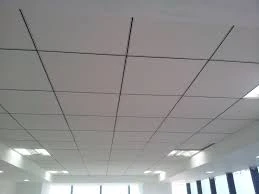Nov . 14, 2024 02:18 Back to list
ceiling metal grid
The Versatility of Ceiling Metal Grids in Modern Architecture
Ceiling metal grids are becoming increasingly popular in contemporary architectural designs, offering a combination of functionality, aesthetics, and versatility. These grid systems are primarily designed to support suspended ceilings, providing a structural framework that accommodates panels or tiles made from various materials. In this article, we will explore the advantages of ceiling metal grids, their applications, and the innovative designs that have emerged in modern architecture.
Advantages of Ceiling Metal Grids
One of the primary benefits of using ceiling metal grids is their strength and durability
. Made from materials such as aluminum or galvanized steel, metal grids can withstand considerable weight and are resistant to corrosion, making them ideal for environments where moisture is a concern, such as bathrooms and commercial kitchens. This resilience ensures that the ceilings maintain their integrity over time, reducing the need for frequent maintenance or replacement.Another significant advantage is the flexibility that metal grids offer in terms of design. They can accommodate various ceiling heights, allowing architects to create spaces that feel open and airy or intimate and cozy. Additionally, metal grids can support various types of ceiling tiles, including acoustic panels that enhance sound absorption, creating a more comfortable environment in busy spaces such as offices, conference rooms, and restaurants.
Metal grid ceilings also enable easy access to utilities concealed above the plaster or paneling. This is particularly important for commercial properties where electrical, HVAC, and plumbing systems require regular maintenance. With a suspended metal grid ceiling, these systems can be easily accessed without causing significant disruption, making it a practical choice for modern buildings.
Applications of Ceiling Metal Grids
ceiling metal grid

Ceiling metal grids find utility in various settings, including commercial, institutional, and residential spaces. In commercial buildings, they are often used in office environments to create dynamic workspace layouts while promoting efficient acoustics and lighting. The ability to customize grid layouts means that architects can design spaces that encourage collaboration or provide privacy as needed.
Institutional buildings such as schools and hospitals benefit from the sound-absorbing properties of metal grid ceilings. In schools, for example, these ceilings help minimize noise, which can be distracting for students. In hospitals, the ability to easily access and maintain the infrastructure above the ceiling is critical to ensuring smooth operations and safety.
In residential spaces, metal grids can be employed to add a modern touch to traditional interiors. Homeowners can opt for sleek metal grid ceilings to create an industrial look in loft-style apartments or modern homes. The combination of metal grids with diverse ceiling tile options allows for endless design possibilities, enabling homeowners to express their style preferences.
Innovative Designs
As architectural trends evolve, so do the designs of ceiling metal grids. Architects and designers are increasingly experimenting with unconventional shapes and materials to create visually striking ceilings. For instance, some modern designs incorporate geometric patterns or integrate lighting fixtures into the metal grid system, thereby enhancing the aesthetic appeal of the ceiling.
Moreover, advances in technology have led to the development of cleaner, more sustainable materials for metal grid systems. Eco-friendly options made from recycled metals or materials that reduce environmental impact are appealing to environmentally conscious consumers and businesses alike.
In conclusion, ceiling metal grids represent a blend of functionality and design versatility in modern architecture. Their durability, ease of maintenance, and adaptability make them a smart choice for a wide range of applications, from commercial spaces to residential homes. As architects continue to push the boundaries of design, metal grids will likely evolve further, offering innovative solutions that meet the demands of contemporary living and working environments. Whether for aesthetic enhancement or practical utility, ceiling metal grids are set to remain a staple in modern architectural design.
-
Durable Ceiling T Grid Systems | Easy InstallationNewsAug.29,2025
-
PVC Gypsum Ceiling: Durable, Laminated Tiles for Modern SpacesNewsAug.28,2025
-
Pvc Gypsum Ceiling Is DurableNewsAug.21,2025
-
Mineral Fiber Board Is DurableNewsAug.21,2025
-
Ceiling Tile Clip Reusable DesignNewsAug.21,2025
-
Ceiling T Grid Modular DesignNewsAug.21,2025







